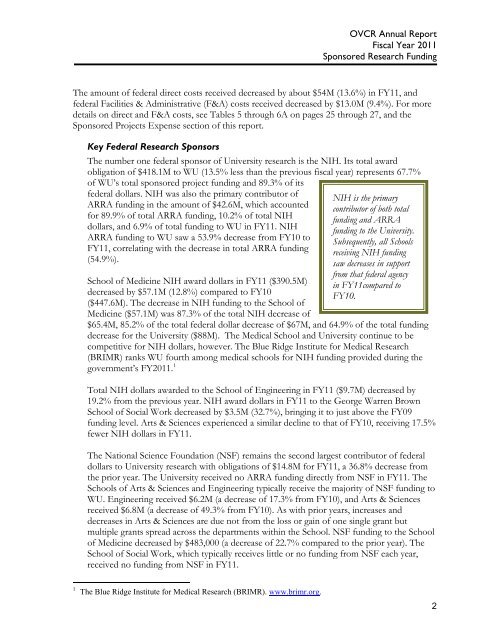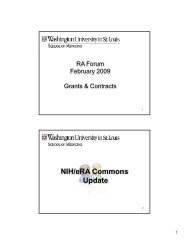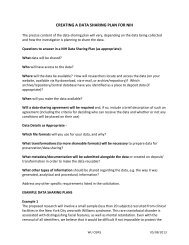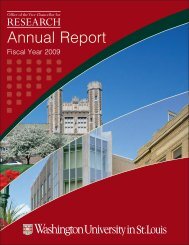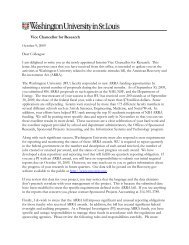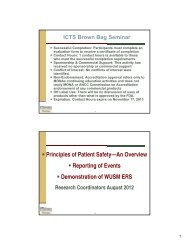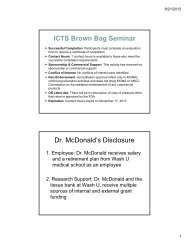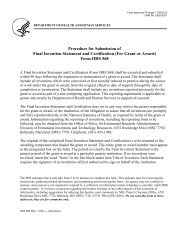A Letter from The Office of the Vice Chancellor for Research
A Letter from The Office of the Vice Chancellor for Research
A Letter from The Office of the Vice Chancellor for Research
Create successful ePaper yourself
Turn your PDF publications into a flip-book with our unique Google optimized e-Paper software.
OVCR Annual ReportFiscal Year 2011Sponsored <strong>Research</strong> Funding<strong>The</strong> amount <strong>of</strong> federal direct costs received decreased by about $54M (13.6%) in FY11, andfederal Facilities & Administrative (F&A) costs received decreased by $13.0M (9.4%). For moredetails on direct and F&A costs, see Tables 5 through 6A on pages 25 through 27, and <strong>the</strong>Sponsored Projects Expense section <strong>of</strong> this report.Key Federal <strong>Research</strong> Sponsors<strong>The</strong> number one federal sponsor <strong>of</strong> University research is <strong>the</strong> NIH. Its total awardobligation <strong>of</strong> $418.1M to WU (13.5% less than <strong>the</strong> previous fiscal year) represents 67.7%<strong>of</strong> WU’s total sponsored project funding and 89.3% <strong>of</strong> itsfederal dollars. NIH was also <strong>the</strong> primary contributor <strong>of</strong>ARRA funding in <strong>the</strong> amount <strong>of</strong> $42.6M, which accounted<strong>for</strong> 89.9% <strong>of</strong> total ARRA funding, 10.2% <strong>of</strong> total NIHdollars, and 6.9% <strong>of</strong> total funding to WU in FY11. NIHARRA funding to WU saw a 53.9% decrease <strong>from</strong> FY10 toFY11, correlating with <strong>the</strong> decrease in total ARRA funding(54.9%).School <strong>of</strong> Medicine NIH award dollars in FY11 ($390.5M)decreased by $57.1M (12.8%) compared to FY10($447.6M). <strong>The</strong> decrease in NIH funding to <strong>the</strong> School <strong>of</strong>Medicine ($57.1M) was 87.3% <strong>of</strong> <strong>the</strong> total NIH decrease <strong>of</strong>NIH is <strong>the</strong> primarycontributor <strong>of</strong> both totalfunding and ARRAfunding to <strong>the</strong> University.Subsequently, all Schoolsreceiving NIH fundingsaw decreases in support<strong>from</strong> that federal agencyin FY11compared toFY10.$65.4M, 85.2% <strong>of</strong> <strong>the</strong> total federal dollar decrease <strong>of</strong> $67M, and 64.9% <strong>of</strong> <strong>the</strong> total fundingdecrease <strong>for</strong> <strong>the</strong> University ($88M). <strong>The</strong> Medical School and University continue to becompetitive <strong>for</strong> NIH dollars, however. <strong>The</strong> Blue Ridge Institute <strong>for</strong> Medical <strong>Research</strong>(BRIMR) ranks WU fourth among medical schools <strong>for</strong> NIH funding provided during <strong>the</strong>government’s FY2011. 1Total NIH dollars awarded to <strong>the</strong> School <strong>of</strong> Engineering in FY11 ($9.7M) decreased by19.2% <strong>from</strong> <strong>the</strong> previous year. NIH award dollars in FY11 to <strong>the</strong> George Warren BrownSchool <strong>of</strong> Social Work decreased by $3.5M (32.7%), bringing it to just above <strong>the</strong> FY09funding level. Arts & Sciences experienced a similar decline to that <strong>of</strong> FY10, receiving 17.5%fewer NIH dollars in FY11.<strong>The</strong> National Science Foundation (NSF) remains <strong>the</strong> second largest contributor <strong>of</strong> federaldollars to University research with obligations <strong>of</strong> $14.8M <strong>for</strong> FY11, a 36.8% decrease <strong>from</strong><strong>the</strong> prior year. <strong>The</strong> University received no ARRA funding directly <strong>from</strong> NSF in FY11. <strong>The</strong>Schools <strong>of</strong> Arts & Sciences and Engineering typically receive <strong>the</strong> majority <strong>of</strong> NSF funding toWU. Engineering received $6.2M (a decrease <strong>of</strong> 17.3% <strong>from</strong> FY10), and Arts & Sciencesreceived $6.8M (a decrease <strong>of</strong> 49.3% <strong>from</strong> FY10). As with prior years, increases anddecreases in Arts & Sciences are due not <strong>from</strong> <strong>the</strong> loss or gain <strong>of</strong> one single grant butmultiple grants spread across <strong>the</strong> departments within <strong>the</strong> School. NSF funding to <strong>the</strong> School<strong>of</strong> Medicine decreased by $483,000 (a decrease <strong>of</strong> 22.7% compared to <strong>the</strong> prior year). <strong>The</strong>School <strong>of</strong> Social Work, which typically receives little or no funding <strong>from</strong> NSF each year,received no funding <strong>from</strong> NSF in FY11.1 <strong>The</strong> Blue Ridge Institute <strong>for</strong> Medical <strong>Research</strong> (BRIMR). www.brimr.org.2


